Related Topics
Revolutionary Philadelphia's Patriots
All kinds of people were patriots in 1776, and many of them were all mixed up about what was going on and how they stood. Hotheads in the London Coffee House stirred up about an inoffensive Tea Act, Scotch-Irish come here to escape the British Crown, the local artisan class and the local smuggler class, unexpectedly prospering under non-importation, and the local gentry -- offended to be denied seats in Parliament like other Englishmen. Pennsylvania wavered until Ben Franklin stepped forward with a plan.
Tourist Walk in Olde Philadelphia
Colonial Philadelphia can be seen in a hard day's walk, if you stick to the center of town.
Favorite Reflections
 In no particular order, here are the author's own favorites.
In no particular order, here are the author's own favorites.
Up Market Street to Sixth and Walnut
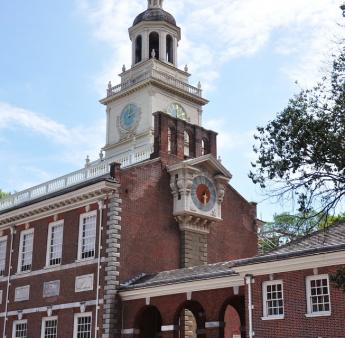 Millions of eye patients have been asked to read the passage from Franklin's autobiography, "I walked up Market Street, etc." which is commonly printed on eye-test cards. Here's your chance to do it.
Millions of eye patients have been asked to read the passage from Franklin's autobiography, "I walked up Market Street, etc." which is commonly printed on eye-test cards. Here's your chance to do it.
The Richest Men in America
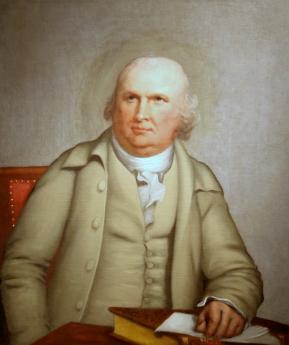
|
| Robert Morris |
Charles Peterson developed the idea but was unsuccessful in popularizing it, that Spruce Street in central Philadelphia could be regarded as an architectural museum. It stretches from river to river but has no bridge or ferry landing at either end, so traffic is less. The earliest house still standing near the Delaware River was built in 1702, with successive houses just a little younger, or at least less old, as you progress toward Broad (14th) Street whose houses were built around 1880. And then onward into the early Twentieth Century, crossing Broad Street and going westward toward the Schuylkill. For a century or more West Spruce Street was where eminent specialists had offices, much like Harley Street in London, which it somewhat resembles. The medical flowering of this area was promoted by the surgical advancements of the nearby Civil War, as well as the contributions of Andrew Carnegie to moving the College of Physicians from 13th street to 21st Street, attracted toward the 7000-bed Civil War hospital which turned into Philadelphia General Hospital in West Philadelphia. A number of these houses are just plain too big to be manageable as single family houses today, and Spruce Street West has lagged Society Hill and other Easterly sections in restoring its buildings. Perhaps in a few decades, that will happen, and perhaps in the meantime, the present relics will be preserved enough to revive someday the idea of a house design museum. Meanwhile, West Philadelphia around Spruce Street has obstructed progression by plonking the University of Pennsylvania, Drexel University and the Science Center as obstacles to residential housing development.
So let's take a simpler idea. For roughly a century, the then-richest men in America lived in one of several houses located within seven blocks of each other, easy walking distance for a tour. The first to attract notice as a self-made rich man was Robert Morris. Morris made his money in shipping, maybe even a little privateering, and then went into banking to keep his money at work. It is said that his personal fortune, adjusted for changes in the currency and economy, was once considerably larger than Bill Gates' would be today, adjusted for inflation. As most people know, Morris financed the American Revolution personally, went broke, ending up in debtor's prison. The first real mansion he lived in was opposite Independence Hall on Market Street, now celebrated as George Washington's while he was the first president. It was earlier the place where British Admiral Gates lived while he was in charge of the 1788 British occupation, and although it was also where Washington lived during most of his presidency, the house burned down in 1832. This house is not to be confused with either the house built for Washington at 9th and Market but never occupied by him or Morris's later mansions which he also never occupied because of financial difficulties. One house in the midst of Jeweler's Row was so ornate some think it contributed heavily to his later bankruptcy. A second Morris house still stands on Eighth Street at St. James Street, but it belonged to the Quaker Morris family, no relation. Other owners named Morris bought and occupied this place for a number of years, so its history is a little mixed up, presently as a fancy restaurant. A DuPont heiress once bought and fixed it up, but her husband commented no one could sleep in that house because a subway built underneath it badly rattled its timbers. Next door to the Quaker Morris house rises a fifty story apartment house, whereas a precaution against rattles, the first nine stories contain nothing but parking spaces. Since the apartment building is owned by Arabs, it is likely they are pretty rich but not necessarily richer than Bill Gates. Aside from the Market Street partial restoration, the main Robert Morris remnant is on Lemon Hill, northwardly opposite the Art Museum, whereas the main Quaker Morris house is in the Morris Arboretum in Chestnut Hill. There are sixty or so Morris's listed in the Social Directory, so keeping the two families distinct remains a difficulty in some circles.
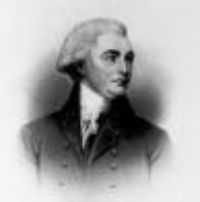
|
| William Bingham |
On the Northeast corner of Third and Spruce Street, once lived William Bingham, a former partner of Morris and later himself the richest man in America. Although sadly the house burned down, it is displayed in one of the famous prints by William Birch in his notable Eighteenth Century collection , widely available in bookstores. The striking thing about Bingham was that he was only twenty-eight years old when he achieved richest-man status and built the house, patterned after one owned by a British Duke. He made his pile three times over. First, running a privateer operation in the Caribbean for his partner Robert Morris. On returning home, he bought up any worthless Continental currency he could stuff into barrels, and then either persuaded his friend Alexander Hamilton to redeem the currency at par or heard his plan to do so. And then, as if he didn't have enough money already, he invested enough gold bars to finance the Louisiana Purchase for Jefferson, since Napoleon wanted gold, please, no paper money. Among the various things he bought as an investment was the area in upstate New York, now called Binghamton. He lost a pile of money buying the land we now call the State of Maine since post-revolutionary Westward migration turned toward Ohio rather than into his Maine holdings once the British prohibition on colonizing past the Allegheny mountains was lifted. Bingham's sister-in-law wanted to become engaged to the heir of the Crown of France, who was living in temporary exile around the corner on Walnut Street. In a famous, possibly fictional, response, the Dauphin was told, No. If you do not become the King of France, you will be no match for her "The Golden Voyage". Quite a good read, and of particular interest to Philadelphia lawyers who learn Bingham died in 1804, but his estate was not settled until 1960. The lawyer who closed the case reported his partners were less than pleased to see it go.
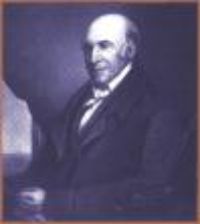
|
| Stephen Girard |
Stephen Girard built several houses a few steps west of Bingham on Spruce Street, identifiable by having marble facing on their lower few feet; Charles Peterson lived in one of them as the first pioneer resident of the Society Hill revival. Girard made his money in the China trade, as a ship's factor. Like Morris, he recognized America's crying need for banking in a story too complicated to repeat here and moved the Girard Bank into the First Bank of America, now a museum (Peale portraits, architectural fragments) of the Park Service on Third Street. His wife was insane, and spent most of her life at the Pennsylvania Hospital at Eight and Spruce, and was eventually buried there. Girard left thirty million dollars to found the Girard College for "poor, white, orphan boys". His 1830 will withstood all legal attacks until the mid-Twentieth Century but was eventually broken. The school now has many black girls, is bankrupt, and the definition of orphan has expanded to include any child whose parents are separated. The definition of "poor" is several times greater than the national definition of the poverty level. In his will, Girard specified that the estate should purchase what is now Schuylkill County and hold it for a century. Shortly thereafter (or just possibly very shortly before that), coal was discovered in the region and Girard College became far richer. His correspondence includes many letters to Lafitte the Pirate, so more may be heard of them.
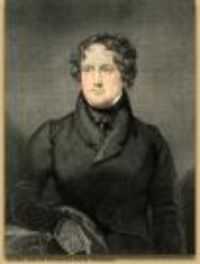
|
| Nichlos Biddle |
Nicholas Biddle had "old money", which he made in the traditional way of buying real estate, particularly in Ohio. He thus made a better guess than Bingham about the likely path of westward migration. But like Morris and Girard, he needed a bank to finance the real estate. Biddle also acted as the reserve bank for the myriads of currencies then issued by individual rural banks and charged a transaction fee to translate Kentucky money into something useful in Philadelphia or abroad. Martin Van Buren, who was the political manipulator behind Andrew Jackson and who became Andrew Jackson's eventual successor, stirred up trouble about this reserve role, and Jackson "broke" Biddle's bank by withdrawing federal deposits. Jackson's complaint was that holding federal "paper" eventually resulted in a government guarantee the bank could never fail, in an echo of the present accusation of some banks being "too big to fail". Ultimately, investment banking began to take its modern formwhen in 1838, the richest man, Anthony J. Drexel, moved over the Schuylkill River on Walnut Street, amidst what is now the University of Pennsylvania, but not far from Drexel University. He walked to work each day, however, at 4th and Chestnut Streets. Drexel was the first big banker to make his fortune in banking, and when he died it was said Philadelphia banking died with him. The earlier big bankers started out with money they had made in shipping or land speculation, but Drexel somehow saw that banking was a different way to get rich, deftly filling in the gap created by Andrew Jackson shuttering Nicholas Biddle's Second Bank. Part of the idea in Van Buren's mind was to shift the focus of American banking from Philadelphia's Chestnut Street to New York's Wall Street, and he was quickly quite successful. J.P. Morgan was invited by Drexel to start a Wall Street partnership with him in correspondence with his father, Junius Morgan, who ran an international bank in London. In the era just after the Civil War, there was a great deal of money in Europe anxious to be invested in the railroads and other booming American industries. The Morgans provided a vehicle for transferring such investment capital between continents, but the Morgans were viewed as having excessively sharp practices. As it happened, Junius Morgan had been trained in this transoceanic concept by George Peabody, a former Baltimore resident who had moved to London, then, the banking capital of the world.
George Peabody earlier had also been involved with Anthony J. Drexel, and Drexel was the more successful of the two international bankers. The whole issue with European investors was whether you could trust those wild and wooly Americans, and Drexel consistently demonstrated he was entitled to be called a straight arrow. As related by a good book by Dan Rottenberg Drexel decided he needed the vigor of the Morgans and invited them to join him in a New York-Philadelphia partnership. From that point forward, JP Morgan was the shining star of honesty and straight dealing, a lesson he evidently learned from Drexel. Indeed, he and his biographers repeatedly stress this feature of him -- "I will never do business with a man I don't trust". He didn't mention women, but his behavior seems to show he probably didn't include them in the concept. Drexel, on the other hand, led a quiet sober life in West Philadelphia, reading books, starting his university, and helping his niece, who was later made a Saint in the Catholic Church, start numerous charities. Although the Drexel children more or less drifted out of sight, Drexel's business successor Stotesbury led a wild and extravagant lifestyle that is the subject of many songs and stories. His wife, for example, never washed the sheets; she always had brand new ones put on the bed. Morgan, of course, spent lots of money in a conspicuous way. The term Metropolitan identifies most of his projects, The Metropolitan Art Museum, The Metropolitan Opera, The Metropolitan Club on Fifth Avenue, with membership originally limited to his partners. The name Corsair also was a trademark, the name of his yachts, and a firm statement about his approach to things. Another difference between the Morgans and the Drexels was similarly in the New York-Philadelphia character. When Jack Morgan, the son of JP, died in the 1930's he left an estate of "only" three million dollars. It would be hard to say what the Drexel fortune was worth at that time, but it is safe to say it would dwarf that, considerably. Most of the Drexel family moved to London, but among other things, financed the restoration of the Benjamin Franklin House on Craven Street, a hundred feet from Trafalgar Square. When the House of Drexel was much blamed for the 1987 stock market crash, legions of Drexel defenders rose to protect the family name. Cabrini College, Eastern University, Valley Forge Military College, St. David's golf course and much of Radnor are only pieces of the Drexel holdings, today.
Originally published: Monday, June 26, 2006; most-recently modified: Friday, May 24, 2019
| Posted by: Charles | Nov 24, 2010 2:41 AM |
| Posted by: George Fisher | Sep 13, 2007 7:35 PM |
| Posted by: kayashi | Sep 12, 2007 8:41 PM |
| Posted by: George Fisher | Aug 7, 2007 2:52 PM |
am a businessmam
| Posted by: DR. KEN | Aug 3, 2007 6:07 PM |